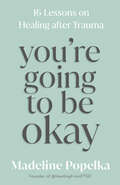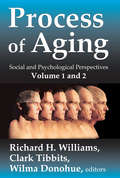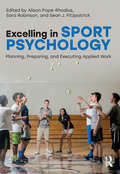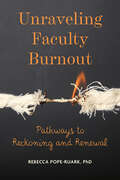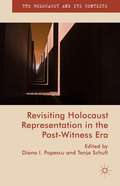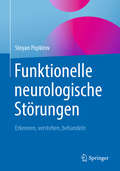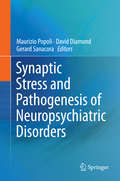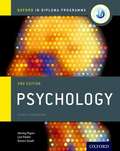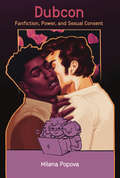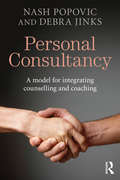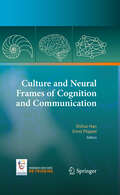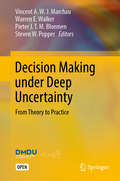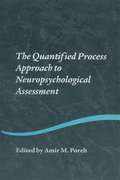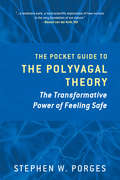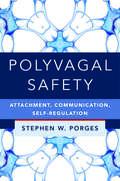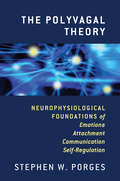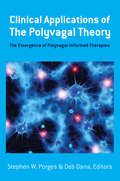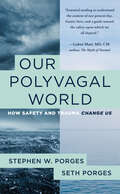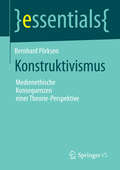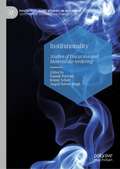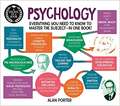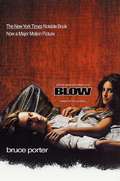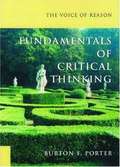- Table View
- List View
You're Going to Be Okay: 16 Lessons on Healing after Trauma
by Madeline PopelkaA hopeful and approachable book written by the creator of @HealingFromPTSD, the largest trauma healing community on Instagram, in which each chapter is inspired by the top-performing posts from the page.In each chapter of You're Going to Be Okay, author Madeline Popelka shares an insight that she gained along her healing journey that shifted her perspective, brought her comfort, reduced her shame, or helped her feel less alone. She weaves in her own personal stories throughout the book, providing readers with the encouragement to keep going so survivors can feel whole again after trauma has turned their world upside down.Readers will find help to release their shame and self-blame as Madeline shows that their experiences are valid, that they aren't "crazy," and that their trauma wasn't their fault--that it's never the victim's fault. They will learn why an experience that doesn't seem "that bad" can still have a profound effect, and that no matter how "small" their trauma may seem they deserve to heal.Many survivors feel like they've lost themselves to trauma, and it can seem impossible to find the upside of an experience that's so devastating. You're Going to Be Okay offers ways to heal that can help them find themselves, and even become improved versions of themselves. This empowering book encourages survivors to share their stories to help others feel less alone, once they're ready and able to, and reminds them that healing is a lifelong journey, and while it can be messy and uncomfortable, there are gifts to be found along the way.
Process of Aging: Social and Psychological Perspectives
by David PopenoeProcesses of Aging: Social and Psychological Perspectives is based on a monumental series of studies on the psychological and social aspects of aging in relation to mental health. This effort gives scientists from North America and Europe an opportunity to explore the concepts, methodological problems, and conclusions of their researches in the rapidly growing field of gerontology. Much work has been done in an attempt to present this material in sequential and systematic fashion. Original work of sixty-six research workers from twelve countries is represented in this two-volume set. They offer an inventory of principal fields of gerontological research, in advanced countries. Human aging, in its many ramifications, is becoming one of the major areas of research interest among an increasing number of students in the biological, behavioral, and social sciences. Although the phenomena of aging were largely overlooked as subject matter for research during the early stages in the development of all basic sciences, it was inevitable that students would eventually become curious about the final processes of maturation. Events of recent years have hastened the need for social action on behalf of older people and, consequently, the need for scientific knowledge about their characteristics, circumstances, and requirements. Processes of Aging: Social and Psychological Perspectives will be of interest to research workers, teachers, and advanced students concerned with the psychological, psychiatric, psychosocial, and socioeconomic aspects of aging. Many of the theoretical and analytical discussions and the specific studies offer guidance for top-level planners and policy administrators in public agencies and voluntary organizations. This volume is highly sensitive to older people as such: how they feel about themselves and the world, and in the way they behave in relation to others. It is must reading in the health and welfare of aging.
Excelling in Sport Psychology: Planning, Preparing, and Executing Applied Work
by Alison Pope-Rhodius Sara Robinson Sean FitzpatrickWritten for graduate students and early professionals who are conducting applied sport psychology work for the first time, Excelling in Sport Psychology is a guide for planning, preparing, and executing this work. Each chapter addresses a critical component of the internship experience, such as selecting a site for an internship, preparing to begin the work, evaluating the completed work, and marketing oneself throughout one’s early career. The diverse experiences of the various authors provide a range of viewpoints for trainees to consider and apply to their growth as sport psychology or mental skills professionals. The text is written in a practical manner, with suggestions and questions that will drive this personal and professional growth. Each chapter also includes a personal account from a current student or recent graduate about their experience in that area. This book will appeal to students in academic sport psychology programs seeking additional support and guidance about the internship process, as well as post-graduates who did not have an internship component to their program. Supervisors will benefit from reading the book as it highlights ways to work with trainees. Drawn from the experience of the applied Sport Psychology department at John F. Kennedy University, which has helped students set up internships, have successful experiences, and attain jobs for over 25 years, this book can provide a model for training programs approaching the challenges of fieldwork.
Unraveling Faculty Burnout: Pathways to Reckoning and Renewal
by Rebecca Pope-RuarkA timely book about assessing, coping with, and mitigating burnout in higher education.Faculty often talk about how busy, overwhelmed, and stressed they are. These qualities are seen as badges of honor in a capitalist culture that values productivity above all else. But for many women in higher education, exhaustion and stress go far deeper than end-of-the-semester malaise. Burnout, a mental health syndrome caused by chronic workplace stress, is endemic to higher education in a patriarchal, productivity-obsessed culture. In this unique book for women in higher education, Rebecca Pope-Ruark, PhD, draws from her own burnout experience, as well as collected stories of faculty in various roles and career stages, interviews with coaches and educational developers, and extensive secondary research to address and mitigate burnout. Pope-Ruark lays out four pillars of burnout resilience for faculty members: purpose, compassion, connection, and balance. Each chapter contains relatable stories, reflective opportunities and exercises, and advice from women in higher education.Blending memoir, key research, and reflection opportunities, Pope-Ruark helps faculty not only address burnout personally but also use the tools in this book to eradicate the systemic conditions that cause it in the first place. As burnout becomes more visible, we can destigmatize it by acknowledging that women are not unraveling; instead, women in higher education are reckoning with the productivity cult embedded in our institutions, recognizing how it shapes their understanding and approach to faculty work, and learning how they can remedy it for themselves, their peers, and women faculty in the future.Contributors: Lee Skallerup Bessette, Cynthia Ganote, Emily O. Gravett, Hillary Hutchinson, Tiffany D. Johnson, Bridget Lepore, Jennifer Marlow, Sharon Michler, Marie Moeller, Valerie Murrenus Pilmaier, Catherine Ross, Kristi Rudenga, Katherine Segal, Kryss Shane, Jennifer Snodgrass, Lindsay Steiner, Kristi Verbeke
Revisiting Holocaust Representation in the Post-Witness Era
by Diana I. PopescuRevisiting Holocaust Representation in the Post-Witness Era shifts focus from discussions on the ethics and limits of representation to the relevance of imagination in Holocaust commemoration. It re-examines ethical, aesthetic and political dilemmas arising from the crucial transfer of memory from the realm of 'living memory' contained by the survivors and their families, to culturally and politically mediated memory practices realised by post-witness generations. Why are artistic imaginative representations of the Holocaust important now? Critical analyses of little discussed artworks, memorials, film, comics and literature point to a diversification of approaches and Holocaust re-presentations in Europe, showing that memory and imagination are increasingly and intimately intertwined. This volume's contributions make apparent the genuine struggle among those born after the Holocaust, whether Jewish, Polish, German, Austrian, or Swedish, to make the past relevant in the present, well-aware that one cannot fully own or comprehend it.
The Architecture of the Roman Triumph
by Maggie L. PopkinThis book offers the first critical study of the architecture of the Roman triumph, ancient Rome's most important victory ritual. Through case studies ranging from the republican to imperial periods, it demonstrates how powerfully monuments shaped how Romans performed, experienced, and remembered triumphs and, consequently, how Romans conceived of an urban identity for their city. Monuments highlighted Roman conquests of foreign peoples, enabled Romans to envision future triumphs, made triumphs more memorable through emotional arousal of spectators, and even generated distorted memories of triumphs that might never have occurred. This book illustrates the far-reaching impact of the architecture of the triumph on how Romans thought about this ritual and, ultimately, their own place within the Mediterranean world. In doing so, it offers a new model for historicizing the interrelations between monuments, individual and shared memory, and collective identities.
Funktionelle neurologische Störungen: Erkennen, verstehen, behandeln
by Stoyan PopkirovDieses Buch bietet eine Übersicht über ein vernachlässigtes Gebiet der Neurologie: Funktionelle Störungen bedingen jeden sechsten Praxisbesuch und etwa 10% der Notfälle und stationären Aufnahmen an neurologischen Kliniken. Dennoch sorgen sie oft für diagnostische Verunsicherung und therapeutische Ratlosigkeit.Praxisnah und evidenzbasiert erläutert der Autor Untersuchungstechniken und klinische Zeichen, die eine frühe und sichere Diagnosestellung jenseits des Ausschlussprinzips möglich machen. Neue Erklärungsmodelle, die Neurophysiologie und Psychosomatik zusammenbringen, verdeutlichen die Entstehungsmechanismen funktioneller Symptome und die Wirkungsweise verschiedener Therapien. Tipps zur ärztlichen Gesprächsführung sowie konkrete Behandlungsempfehlungen aus der Physiotherapie und Psychotherapie sollen die interdisziplinäre Patientenversorgung erleichtern.
Synaptic Stress and Pathogenesis of Neuropsychiatric Disorders
by Maurizio Popoli David Diamond Gerard SanacoraRecent studies show that changes in Glutamate/GABA synapses and related pathways may determine whether the synaptic plasticity that occurs as a response to stress is adaptive or maladaptive. Findings have shed new light on the mechanisms that determine the effects of stress on cognitive and affective function. Researchers have brought a wide range of techniques to bear on the study of this problem, including cutting-edge live imaging techniques, electrophysiology, glutamate release from isolated live synaptic terminals, development of transgenic and animal models and new behavioral methods. This book provides an overview of these recent findings and of the techniques used as well as a discussion of how the molecular, cellular, and functional effects of stress may trigger or precipitate neuropsychiatric disorders such as depression, schizophrenia, anxiety and PTSD.
IB Psychology Course Book: Oxford IB Diploma Programme
by Alexey Popov Lee Parker Darren SeathComprehensively updated for the latest syllabus, for first teaching September 2017, and developed directly with the IB, the second edition of this popular Psychology Course Book provides thorough coverage of all core and optional units at Standard and Higher Level, as well as assessment preparation support. Engaging, full-colour activities and in-depth, international case studies bring the theory to life, while structured opportunities for critical thinking and concept-based learning help to develop enquiring and independent learners. Clear and accessible language, a robust reference section, support for the Internal Assessment and TOK links ensure that all learners progress through the DP Psychology course with confidence.
Dubcon: Fanfiction, Power, and Sexual Consent
by Milena PopovaHow the treatment of sexual consent in erotic fanfiction functions as a form of cultural activism.Sexual consent is--at best--a contested topic in Western societies and cultures. The #MeToo movement has brought public attention to issues of sexual consent, revealing the endemic nature of sexual violence. Feminist academic approaches to sexual violence and consent are diverse and multidisciplinary--and yet consent itself is significantly undertheorized. In Dubcon, Milena Popova points to a community that has been considering issues of sex, power, and consent for many years: writers and readers of fanfiction. Their nuanced engagement with sexual consent, Popova argues, can shed light on these issues in ways not available to either academia or journalism. Popova explains that the term "dubcon" (short for "dubious consent") was coined by the fanfiction community to make visible the gray areas between rape and consent--for example, in situations where the distribution of power may limit an individual's ability to give meaningful consent to sex. Popova offers a close reading of three fanfiction stories in the Omegaverse genre, examines the "arranged marriage" trope, and discusses the fanfiction community's response when a sports star who was a leading character in RPF (real person fiction) was accused of rape. Proposing that fanfiction offers a powerful discursive resistance on issues of rape and consent that challenges dominant discourses about gender, romance, sexuality, and consent, Popova shows that fanfiction functions as a form of cultural activism.
Personal Consultancy: A model for integrating counselling and coaching
by Nash Popovic Debra JinksMaking the case for an integrated approach to the practices of counselling, psychotherapy and coaching, Personal Consultancy provides a coherent and systematic framework for working with clients. Nash Popovic and Debra Jinks use their experience in the area of integrative practice to demonstrate how this wider approach can be a more comprehensive way of helping clients than coaching or counselling on its own. The authors explain how a range of techniques and approaches from various one-to-one practices can be brought together under the framework of Personal Consultancy, creating a method that is systematic, ethical and professional but not limited by any particular theoretical bias or preconceptions. With chapters by guest authors who discuss their perspectives on the approach and its application across various contexts, Personal Consultancy demonstrates that it is possible to combine the reparative work normally associated with counselling with the more proactive, goal-oriented approach of coaching. The result is a method that allows clients to have their counselling and their coaching needs met within one relationship and which allows the practitioner more flexibility and freedom than when using a single approach. Personal Consultancy will be essential reading for practicing coaches and counsellors, especially those already integrating the two approaches or those looking to do so, as well as students and those in training.
Culture and Neural Frames of Cognition and Communication (On Thinking #3)
by Ernst Pöppel Shihui HanCultural neuroscience combines brain imaging techniques such as functional magnetic resonance imaging and event-related brain potentials with methods of social and cultural psychology to investigate whether and how cultures influence the neural mechanisms of perception, attention, emotion, social cognition, and other human cognitive processes. The findings of cultural neuroscience studies improve our understanding of the relation between human brain function and sociocultural contexts and help to reframe the "big question" of nature versus nurture. This book is organized so that two chapters provide general views of the relation between biological evolution, cultural evolution and recent cultural neuroscience studies, while other chapters focus on several aspects of human cognition that have been shown to be strongly influenced by sociocultural factors such as self-concept representation, language processes, emotion, time perception, and decision-making. The main goal of this work is to address how thinking actually takes place and how the underlying neural mechanisms are affected by culture and identity.
Decision Making under Deep Uncertainty: From Theory To Practice
by Steven W. Popper Warren E. Walker Vincent A. W. J. Marchau Pieter J. T. M. BloemenThis open access book focuses on both the theory and practice associated with the tools and approaches for decisionmaking in the face of deep uncertainty. It explores approaches and tools supporting the design of strategic plans under deep uncertainty, and their testing in the real world, including barriers and enablers for their use in practice. The book broadens traditional approaches and tools to include the analysis of actors and networks related to the problem at hand. It also shows how lessons learned in the application process can be used to improve the approaches and tools used in the design process. The book offers guidance in identifying and applying appropriate approaches and tools to design plans, as well as advice on implementing these plans in the real world. For decisionmakers and practitioners, the book includes realistic examples and practical guidelines that should help them understand what decisionmaking under deep uncertainty is and how it may be of assistance to them. <p><p> Decision Making under Deep Uncertainty: From Theory to Practice is divided into four parts. Part I presents five approaches for designing strategic plans under deep uncertainty: Robust Decision Making, Dynamic Adaptive Planning, Dynamic Adaptive Policy Pathways, Info-Gap Decision Theory, and Engineering Options Analysis. Each approach is worked out in terms of its theoretical foundations, methodological steps to follow when using the approach, latest methodological insights, and challenges for improvement. In Part II, applications of each of these approaches are presented. Based on recent case studies, the practical implications of applying each approach are discussed in depth. Part III focuses on using the approaches and tools in real-world contexts, based on insights from real-world cases. Part IV contains conclusions and a synthesis of the lessons that can be drawn for designing, applying, and implementing strategic plans under deep uncertainty, as well as recommendations for future work.
The Quantified Process Approach to Neuropsychological Assessment (Studies on Neuropsychology, Neurology and Cognition)
by Amir M. PorehSince the late 1800s psychologists have been interested in discerning the strategies subjects employ to solve psychological tests (Piaget, 1928, Werner, 1940, Gesell, 1941). Much of this work, however, has relied on qualitative observations. In the 1970s, Edith Kaplan adopted this approach to the analysis of standardized neuropsychological measures. Unlike her predecessors, Dr. Kaplan and her colleagues emphasized the application of modern behavioral neurology to the analysis of the test data. Her approach was later termed the Boston Process Approach to neuropsychological assessment. While Edith Kaplan's work generates a great deal of enthusiasm, the qualitative nature of her analyses did not allow for its adoption by mainstream neuropsychologists. However, in recent years this limitation has begun to be addressed. Clinicians and researchers have developed new methodologies for quantifying the Boston Process Approach, leading to the emergence of a new field, which is collectively termed the Quantified Process Approach. Quantified Process Approach to Neuropsychological Assessment outlines the rationale for the emergence of this new approach and reviews the state of the art research literature and up to date clinical applications as they pertain to the evaluation of neuropsychiatric, head injured, and learning disabled patients. When available, norms and scoring forms are included in the appendices.
The Pocket Guide to the Polyvagal Theory: The Transformative Power Of Feeling Safe (Norton Series on Interpersonal Neurobiology #0)
by Stephen W. PorgesBridging the gap between research, science, and the therapy room. When The Polyvagal Theory was published in 2011, it took the therapeutic world by storm, bringing Stephen Porges’s insights about the autonomic nervous system to a clinical audience interested in understanding trauma, anxiety, depression and other mental health issues. The book made accessible to clinicians and other professionals a polyvagal perspective that provided new concepts and insights for understanding human behavior. The perspective placed an emphasis on the important link between psychological experiences and physical manifestations in the body. That book was brilliant but also quite challenging to read for some. Since publication of that book, Stephen Porges has been urged to make these ideas more accessible and The Pocket Guide to the Polyvagal Theory is the result. Constructs and concepts embedded in polyvagal theory are explained conversationally in The Pocket Guide and there is an introductory chapter which discusses the science and the scientific culture in which polyvagal theory was originally developed. Publication of this work enables Stephen Porges to expand the meaning and clinical relevance of this groundbreaking theory.
Polyvagal Safety: 50 Client-centered Practices (IPNB #0)
by Stephen W. PorgesThe foundational role of safety in our lives. Ever since publication of The Polyvagal Theory in 2011, demand for information about this innovative perspective has been constant. Here Stephen W. Porges brings together his most important writings since the publication of that seminal work. At its heart, polyvagal theory is about safety. It provides an understanding that feeling safe is dependent on autonomic states, and that our cognitive evaluations of risk in the environment, including identifying potentially dangerous relationships, play a secondary role to our visceral reactions to people and places. Our reaction to the continuing global pandemic supports one of the central concepts of polyvagal theory: that a desire to connect safely with others is our biological imperative. Indeed, life may be seen as an inherent quest for safety. These ideas, and more, are outlined in chapters on therapeutic presence, group psychotherapy, yoga and music therapy, autism, trauma, date rape, medical trauma, and COVID-19.
The Polyvagal Theory: Neurophysiological Foundations of Emotions, Attachment, Communication, and Self-regulation (Norton Series on Interpersonal Neurobiology)
by Stephen W. PorgesA collection of groundbreaking research by a leading figure in neuroscience. This book compiles, for the first time, Stephen W. Porges's decades of research. A leading expert in developmental psychophysiology and developmental behavioral neuroscience, Porges is the mind behind the groundbreaking Polyvagal Theory, which has startling implications for the treatment of anxiety, depression, trauma, and autism. Adopted by clinicians around the world, the Polyvagal Theory has provided exciting new insights into the way our autonomic nervous system unconsciously mediates social engagement, trust, and intimacy.
Clinical Applications of the Polyvagal Theory: The Emergence Of Polyvagal-informed Therapies (Norton Series on Interpersonal Neurobiology #0)
by Stephen W. Porges Deb A. DanaInnovative clinicians share their experiences integrating Polyvagal Theory into their treatment models. Clinicians who have dedicated their work to bringing the benefits of the Polyvagal Theory to a range of clients have come together to present Polyvagal Theory in a creative and personal way. Chapters on a range of topics from compassionate medical care to optimized therapeutic relationships to clinician's experiences as parents extract from the theory the powerful influence and importance of cases and feelings of safety in the clinical setting. Additionally, there are chapters which: elaborate on the principle of safety in clinical practice with children with abuse histories explain the restorative consequences of movement, rhythm, and dance in promoting social connectedness and resilience in trauma survivors explains how Polyvagal Theory can be used to understand the neurophysiological processes in various therapies discuss dissociative processes and treatments designed to experience bodily feelings of safety and trust examine fear of flying and how using positive memories as an active "bottom up" neuroceptive process may effectively down-regulate defense shed light on the poorly understood experience of grief Through the insights of innovative and benevolent clinicians, whose treatment models are Polyvagal informed, this book provides an accessible way for clinicians to embrace this groundbreaking theory in their own work.
Our Polyvagal World: How Safety and Trauma Change Us
by Stephen W. Porges Seth PorgesThe creator of the Polyvagal Theory explains the principles in simple terms that are accessible to all. Since Stephen Porges first proposed the Polyvagal Theory in 1994, its basic idea—that the level of safety we feel impacts our health and happiness—has radically shifted how researchers and clinicians approach trauma interventions and therapeutic interactions. Yet despite its wide acceptance, most of the writing on the topic has been obscured behind clinical texts and scientific jargon. Our Polyvagal World definitively presents how Polyvagal Theory can be understandable to all and demonstrates how its practical principles are applicable to anyone looking to live their safest, best, healthiest, and happiest life. What emerges is a worldview filled with optimism and hope, and an understanding as to why our bodies sometimes act in ways our brains wish they didn’t. Filled with actionable advice and real-world examples, this book will change the way you think about your brain, body, and ability to stay calm in a world that feels increasingly overwhelming and stressful.
Konstruktivismus: Medienethische Konsequenzen einer Theorie-Perspektive (essentials)
by Bernhard PörksenDieser Essay stellt sich einem doppelten Anspruch: Zum einen soll - kurz und knapp - in die Erkenntnistheorie des Konstruktivismus eingeführt werden, die in den verschiedensten Disziplinen (Medien- und Kommunikationswissenschaft, Soziologie etc. ) für Aufsehen gesorgt hat. Zum anderen gilt es zu zeigen, in welcher Weise die Kernaussagen und Prämissen des Konstruktivismus (Abschied von der Idee absoluter Wahrheitserkenntnis, Orientierung am ,,Beobachter" bzw. dem Erkennenden, Akzeptanz der Pluralität von Wirklichkeitskonstruktionen etc. ) für die medienethischen Debatten folgenreich sind. Deutlich wird, dass die konstruktivistischen Einsichten zu einer grundsätzlichen Skepsis inspirieren und eine radikale Verantwortungsethik begründbar machen. Jeder ist, so das hier entfaltete Argument, für seine Wirklichkeitskonstruktion verantwortlich.
Institutionality: Studies of Discursive and Material (Re-)ordering (Postdisciplinary Studies in Discourse)
by Yannik Porsché Ronny Scholz Jaspal Naveel SinghThis edited book brings together humanities and social sciences scholars from the various disciplines at the nexus of discourse studies and ethnography to reflect on questions of institutional practices and their political concerns. Institutional order plays an important role in structuring power relations in society. Yet, contrary to common understandings of structure, institutional orders are far from fixed or stable. They constantly change, and they are resisted and reimagined by social actors. The 20 studies collected in this edited volume develop the notion of institutionality as an overarching perspective to explore how institutional actors and institutional practices order and reorder power in societies across the globe. Thereby the chapters pay special attention to the fluidity, volatility, fragility, and ambiguity of order, and consequently to its claims to authority. Employing a broad range of discourse analytic and ethnographic methodologies, the studies show how institutions are discursively and materially constructed, defined, represented and how they are made relevant and become powerful – or how they are resisted, transformed or lose significance – in interaction. Readers will obtain nuanced insights into ways in which differently positioned social actors engage in struggles about how institutions can be imagined and enacted across several domains, such as workplace interactions, architecture, mass-media representations or organisational publicity. This book will be of interest to readers in Applied Linguistics, Discourse and Society, Critical Discourse Analysis, Political Theory and Communication Studies.
Meeting Democracy
by Donatella Della Porta Dieter RuchtThe concepts of power and democracy have been extensively studied at the global, national and local levels and within institutions including states, international organizations and political parties. However, the interplay of those concepts within social movements is given far less attention. Studies have so far mainly focused on their protest activities rather than the internal practices of deliberation and democratic decision-making. 'Meeting Democracy' presents empirical research that examines in detail how power is distributed and how consensus is reached in twelve global justice movement organizations, with detailed observations of how they operate in France, Germany, Italy, Spain, Switzerland and the UK. Written by leading political scientists and sociologists, this work contributes significantly to the wider literature on power and deliberative democracy within political science and sociology.
Psychology (Degree in a Book Series)
by Alan PorterThis book provides the reader with an overview of the different areas of psychology that are covered on a typical psychology degree course. Each chapter gives a general overview of the topic and introduces important concepts and research methods. In a series of boxes, important studies, individuals or methods are explored in greater depth. This will allow the reader to get a sense of the general ‘lie of the land’ and also a sense of the style of research carried out in different areas. At the end of the book, there is a section on further reading that provides a short, chapter-by-chapter, bibliography of books suitable for the general reader and textbooks targeted at psychology students.
Blow: How a Small-Town Boy Made $100 Million with the Medellin Cocaine Cartel and Lost It All
by Bruce PorterBLOW is the unlikely story of George Jung's roller coaster ride from middle-class high school football hero to the heart of Pable Escobar's Medellin cartel-- the largest importer of the United States cocaine supply in the 1980s. Jung's early business of flying marijuana into the United States from the mountains of Mexico took a dramatic turn when he met Carlos Lehder, a young Colombian car thief with connections to the then newly born cocaine operation in his native land. Together they created anew model for selling cocaine, turning a drug used primarily by the entertainment elite into a massive and unimaginably lucrative enterprise-- one whose earnings, if legal, would have ranked the cocaine business as the sixth largest private enterprise in the Fortune 500. The ride came to a screeching halt when DEA agents and Florida police busted Jung with three hundred kilos of coke, effectively unraveling his fortune. But George wasn't about to go down alone. He planned to bring down with him one of the biggest cartel figures ever caught. With a riveting insider account of the lurid world of international drug smuggling and a super-charged drama of one man's meteoric rise and desperate fall, Bruce Porter chronicles Jung's life using unprecedented eyewitness sources in this critically acclaimed true crime classic.
The Voice of Reason: Fundamentals of Critical Thinking
by Burton F. PorterLively, comprehensive, and contemporary, The Voice of Reason: Fundamentals of Critical Thinking covers three principal areas: thought and language, systematic reasoning, and modes of proof. It employs highly accessible explanations and a multitude of examples drawn from social issues and various academic fields, showing students and other readers how to construct and criticize arguments using the techniques of sound reasoning. The Voice of Reason examines the traditional elements of the field and also explores new ground. The first section of the book elucidates the relationship between thought and language, explaining how words function. It discusses meaning, connotation, vagueness, ambiguity, and definition, identifying the linguistic elements that can produce mistakes in thinking. The next section describes the rules of systematic reasoning, examining such topics as truth, relevance, and adequacy; deductive logic (categorical, hypothetical, and disjunctive); and induction (cause and effect, analogy, generalization, and hypothesis). Sixteen fallacies in thinking are also described through extensive illustrations and applications. The final section of the book offers a unique study of what constitutes proof in several different areas--including politics, advertising, law, and social issues--as well as in the academic disciplines of literature, science, history, and ethics. The author describes the various rules of evidence, using essays by major figures in each field as examples. An ideal text for courses in critical thinking, informal logic, and reasoning and writing, The Voice of Reason offers numerous pedagogical features including a host of examples; assignments, exercises, and puzzles at both the halfway point and at the end of each chapter; cartoons and quotations throughout; and practical applications of theoretical concepts.
